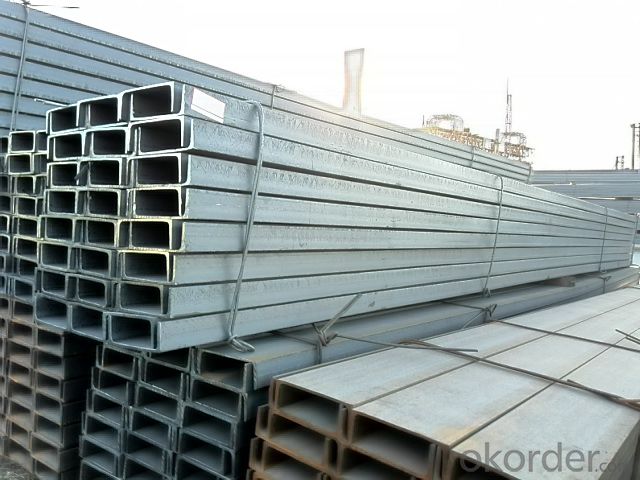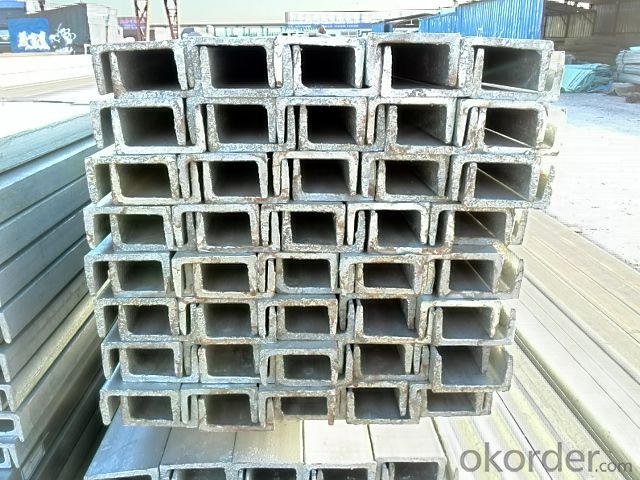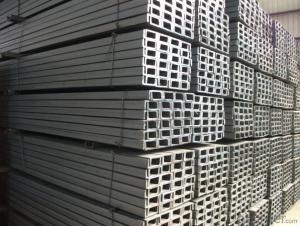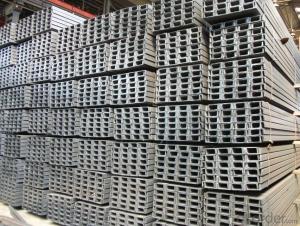U-Channels Source from China Market with Best Price
- Loading Port:
- Tianjin
- Payment Terms:
- TT OR LC
- Min Order Qty:
- 25 m.t
- Supply Capability:
- 10000 m.t/month
OKorder Service Pledge
OKorder Financial Service
You Might Also Like
Item specifice
OKorder is offering high quality Hot Rolled U-Channels at great prices with worldwide shipping. Our supplier is a world-class manufacturer of steel, with our products utilized the world over. OKorder annually supplies products to European, North American ,Africa and Asian markets. We provide quotations within 24 hours of receiving an inquiry and guarantee competitive prices.
Product Applications:
Hot Rolled U-Channels are ideal for structural applications and are widely used in the construction of buildings and bridges, and the manufacturing, petrochemical, and transportation industries.
Product Advantages:
OKorder's U-Channels are durable, strong, and resist corrosion.Most important ,our price is evry competitive.
Main Product Features:
· Premium quality
· Prompt delivery & seaworthy packing (30-45 days after receiving deposit)
· Corrosion resistance
· Can be recycled and reused
· Mill test certification
· Professional Service
· Competitive pricing
Product Specifications:
Manufacture: Hot rolled
Grade: Q235/SS400
Certificates: ISO, SGS, BV, CIQ
Length: 6m – 12m, as per customer request
Packaging: Export packing, nude packing, bundle
JIS U CHANNEL | Standard | Sectional | Dimension |
| Mass: |
(mm) | (mm) | (mm) | (mm) | ||
50x25 | 50 | 25 | 3.0 | 6.00 | 2.37 |
75X40 | 75 | 40 | 3.8 | 7.00 | 5.30 |
75X40 | 75 | 40 | 4.0 | 7.00 | 5.60 |
75X40 | 75 | 40 | 4.5 | 7.00 | 5.85 |
75X40 | 75 | 40 | 5.0 | 7.00 | 6.92 |
100X50 | 100 | 50 | 3.8 | 6.00 | 7.30 |
100X50 | 100 | 50 | 4.2 | 6.00 | 8.03 |
100X50 | 100 | 50 | 4.5 | 7.50 | 8.97 |
100X50 | 100 | 50 | 5.0 | 7.50 | 9.36 |
125X65 | 125 | 65 | 5.2 | 6.80 | 11.66 |
125X65 | 125 | 65 | 5.3 | 6.80 | 12.17 |
125X65 | 125 | 65 | 5.5 | 8.00 | 12.91 |
125X65 | 125 | 65 | 6.0 | 8.00 | 13.40 |
150x75 | 150 | 75 | 5.5 | 7.30 | 14.66 |
150x75 | 150 | 75 | 5.7 | 10.00 | 16.71 |
150x75 | 150 | 75 | 6.0 | 10.00 | 17.90 |
150x75 | 150 | 75 | 6.5 | 10.00 | 18.60 |
150x75 | 150 | 75 | 6.5 | 10.00 | 24.00 |
200X80 | 200 | 80 | 7.5 | 11.00 | 24.60 |
FAQ:
Q1: Why buy Materials & Equipment from OKorder.com?
A1: All products are carefully selected from China's most reliable manufacturing enterprises. Through its ISO certifications, OKorder.com adheres to the highest standards and a commitment to supply chain safety and customer satisfaction.We can guarantee the quality!
Q2:What's your payment terms ?
A2: We can accecpt T/T,LC at sight and time LC.
Q3: You selling on theoretical weight basis or actual weight basis ?
A3: Yes, we can do both ,deponding on buyers' needs .
Images


- Q:What are the factors that affect the price of steel channels?
- There are several factors that can impact the price of steel channels. 1. Raw material costs: The price of steel channels is heavily influenced by the cost of raw materials, particularly steel. Fluctuations in the price of iron ore, coal, and other materials used in steel production can directly affect the cost of manufacturing steel channels. 2. Supply and demand: The overall demand for steel channels in the market can impact their price. If demand is high and supply is limited, prices are likely to increase. Conversely, if demand is low and there is excess supply, prices may decrease. 3. Manufacturing and processing costs: The cost of producing steel channels, including labor, energy, and equipment expenses, can impact the final price. Higher manufacturing costs may lead to higher prices for steel channels. 4. Market competition: The level of competition among steel channel manufacturers can also influence prices. When there are multiple producers offering similar products, they may engage in price competition to attract customers, resulting in lower prices. Conversely, if there are fewer suppliers or if they have a unique product, prices may be higher. 5. Transportation and logistics: The cost of transporting steel channels from manufacturing facilities to distribution centers or end-users can impact the final price. Factors such as fuel prices, shipping distances, and transportation infrastructure can all affect transportation costs, which may be passed on to the buyer. 6. Government regulations and tariffs: Trade policies, import duties, and government regulations can also affect the price of steel channels. Tariffs imposed on imported steel channels can increase their price, while government subsidies or support can lead to lower prices. 7. Economic conditions: Overall economic conditions, both globally and domestically, can have an impact on steel channel prices. Factors such as economic growth, inflation, and currency exchange rates can all influence the cost of steel channels. It is important to note that these factors are interrelated and can vary depending on the specific market dynamics and location. Therefore, understanding these factors and their potential impact is crucial for buyers and sellers in the steel channel industry.
- Q:What are the considerations for steel channel bracing?
- When contemplating steel channel bracing, there are several crucial factors that need to be taken into consideration. To begin with, it is of utmost importance to assess the structural requirements of the building or structure that the bracing will be supporting. This entails evaluating the loads and forces that will be exerted on the bracing system, as well as understanding the specific design codes and standards that must be adhered to. Ensuring that the bracing system can endure the expected loads and provide the required stability to the structure is absolutely essential. Secondly, careful consideration must be given to the material properties of the steel channel used for bracing. This involves evaluating the strength, stiffness, and ductility of the steel channel. Selecting a steel channel with the appropriate properties to withstand the loads and forces imposed on the bracing system is of great importance. Additionally, factors like corrosion resistance and fire resistance should also be taken into account. Another factor to consider is the design and layout of the bracing system. The spacing and arrangement of the steel channel braces should be meticulously planned to ensure sufficient support and stability. The bracing system should be designed in a manner that effectively distributes the loads and minimizes the potential for buckling or instability. Furthermore, the connections between the steel channel braces and the supporting structure should be strong and capable of efficiently transferring the loads. In addition to the design and layout, the installation of the steel channel bracing is a crucial aspect to consider. Proper installation techniques must be followed to ensure correct and secure installation of the bracing system. This involves using suitable fasteners and ensuring that the bracing is aligned and connected properly. Lastly, it is important to take into account any potential limitations or restrictions that may impact the steel channel bracing. This could include factors such as available space for installation, access for maintenance or repair, or any specific environmental conditions that could affect the performance of the bracing system. Overall, by carefully considering the structural requirements, material properties, design and layout, installation techniques, and any limitations or restrictions, one can ensure that the steel channel bracing is effective and provides the necessary support and stability for the structure.
- Q:Can steel channels be used for roof trusses?
- Indeed, roof trusses can make use of steel channels. In construction, steel channels are frequently employed due to their robustness and longevity. It is possible to produce steel channels with precise measurements, facilitating exceptional support for roof trusses. Furthermore, steel channels possess resistance against warping, splitting, and shrinking, thereby establishing their dependability as a suitable option for roof trusses.
- Q:How do steel channels contribute to the overall stability of a bridge?
- The presence of steel channels is crucial in the construction of bridges, as they ensure the bridge's overall stability and structural integrity. These channels, also referred to as structural steel sections, make several essential contributions to the bridge's stability. The primary function of steel channels is to evenly distribute the load and weight of the bridge across its span. Acting as horizontal beams, they effectively transfer the loads from the bridge deck to the supporting piers or abutments. This load distribution prevents any concentration of stress in specific areas, ensuring that the bridge can withstand the forces it encounters, such as the weight of vehicles, wind, or seismic events. Furthermore, steel channels also play a role in maintaining the bridge's torsional stability. Torsional forces can arise from various factors, including uneven loading, wind gusts, or the distribution of the bridge's own weight. By strategically incorporating steel channels into the bridge's design, these sections resist torsional forces, preventing any twisting or warping of the structure. This ensures that the bridge remains stable and maintains its intended shape over time. Additionally, steel channels contribute to the stiffness and rigidity of the bridge. By connecting different structural elements, such as beams and columns, they provide an effective bracing system. This bracing prevents excessive deflection or bending of the bridge under loads, reducing the potential for deformation or failure. The added stiffness and rigidity offered by steel channels also help minimize the bridge's vibrations, providing a smoother and more comfortable experience for users. Moreover, steel channels offer versatility in design and installation. They can be fabricated into various shapes and sizes, allowing engineers to customize the bridge's structural components to meet the specific project requirements. This adaptability facilitates the optimization of the bridge's stability, enabling it to withstand different loads and environmental conditions. In conclusion, steel channels play a vital role in ensuring the overall stability of bridges. They contribute to load distribution, torsional stability, stiffness, and rigidity, allowing the bridge to safely support traffic loads and withstand external forces. The versatility of steel channels also allows engineers to create efficient and optimized bridge designs, enhancing the structural integrity and longevity of these essential infrastructural elements.
- Q:What is the difference between channel steel and C steel?
- Channel steel is produced by hot rolling, supplied directly by iron and steel works, and thicker
- Q:What are the considerations for steel channel connections to timber structures?
- When considering steel channel connections to timber structures, there are a few important factors to take into account. These considerations include the compatibility of materials, load capacity, joint design, and potential for corrosion. First and foremost, it is crucial to ensure that the steel channel and timber are compatible materials. This involves assessing the mechanical properties of both materials, such as their strength and stiffness. Additionally, any potential chemical reactions between the materials should be considered to avoid corrosion or degradation. The load capacity of the connection is another crucial consideration. The steel channel must be able to support the anticipated loads without compromising the structural integrity of the timber. This requires a thorough analysis of the applied loads, including static and dynamic forces, as well as any potential impact or wind loads. The design of the joint is also critical for a successful connection. The steel channel should be properly sized and positioned to distribute the loads evenly across the timber members. This may involve using appropriate fasteners, such as bolts or screws, and ensuring that they are properly installed and tightened to achieve the desired level of connection strength. Finally, the potential for corrosion should be carefully evaluated. Steel is susceptible to corrosion when exposed to moisture or chemicals, which can weaken the connection over time. Proper protective measures, such as galvanizing or coating the steel channel, should be considered to prevent corrosion and extend the lifespan of the connection. Overall, when connecting steel channels to timber structures, it is essential to consider material compatibility, load capacity, joint design, and corrosion prevention to ensure a safe and durable connection. By addressing these considerations, the connection can effectively transfer loads and maintain the structural integrity of the timber structure.
- Q:Can steel channels be used in rooftop installations?
- Indeed, rooftop installations can utilize steel channels. In the realm of construction, steel channels are frequently employed due to their robustness and resilience. In the context of rooftop installations, steel channels serve numerous functions, encompassing support for solar panels, HVAC units, and other equipment. Notably, they furnish a stable and dependable foundation for these installations, effectively enduring the weight and strain associated with rooftop applications. Additionally, steel channels can be tailor-made and manufactured to meet specific needs, ensuring effortless installation on rooftops. In summary, steel channels prove themselves to be a dependable and pragmatic option for rooftop installations.
- Q:What are the different types of support brackets for steel channels?
- There are several types of support brackets that can be used for steel channels. Some of the most common types include: 1. Cantilever brackets: These brackets are designed to support the steel channel from one end, allowing it to extend freely without any support on the other end. Cantilever brackets are often used when the steel channel needs to be suspended or when there is limited space for traditional support brackets. 2. L-shaped brackets: L-shaped brackets are one of the most basic and commonly used types of support brackets for steel channels. They have a 90-degree angle shape, with one side attached to the wall or structure, and the other side supporting the steel channel. L-shaped brackets provide stability and are often used in applications where the channel needs to be securely fixed to a wall or surface. 3. U-shaped brackets: U-shaped brackets, also known as pipe hangers or pipe clamps, are used to support steel channels that are carrying pipes or tubes. These brackets have a U-shaped design that allows the channel to sit securely within the bracket, providing stability and preventing any movement or vibration. U-shaped brackets are commonly used in plumbing, HVAC, and electrical installations. 4. Angle brackets: Angle brackets, as the name suggests, have an angled shape and are used to support steel channels at an angle. They are often used in applications where the channel needs to be mounted diagonally or where additional support is required to withstand heavy loads or forces. Angle brackets are versatile and can be adjusted to different angles to suit specific installation requirements. 5. Strut brackets: Strut brackets are specially designed to support steel channels that are part of a strut system. These brackets are typically made of metal and have holes or slots that allow the channel to be securely attached. Strut brackets provide a flexible and adjustable support solution, allowing the channel to be easily adjusted or repositioned as needed. It is important to consider the specific requirements of your application when choosing a support bracket for steel channels. Factors such as load capacity, installation method, and environmental conditions should be taken into account to ensure the proper support and stability of the steel channel.
- Q:Can steel channels be used for access platforms?
- Yes, steel channels can be used for access platforms. Steel channels are commonly used in the construction of access platforms due to their strength and durability. They provide a sturdy framework for supporting and securing the platform, ensuring the safety of workers while accessing elevated areas. The versatility of steel channels allows for customization and adaptation to different platform designs and requirements. Additionally, steel channels can be easily welded or bolted together, making them a convenient choice for constructing access platforms.
- Q:What are the weight calculations for steel channels?
- To determine the weight of steel channels, one can utilize the following formula: Weight can be found by multiplying the cross-sectional area with the density of steel. The cross-sectional area of a steel channel can be determined by multiplying the width (W), height (H), and thickness (T) of the web. In the case of tapered flanges, the average width (Wa) of the flanges should be employed. To calculate the cross-sectional area, add twice the average width of the flanges to the width, multiply the sum by the height, and add the product of the thickness and width. The density of steel typically measures approximately 7,850 kilograms per cubic meter (kg/m³). Hence, the weight of the steel channel can be established by multiplying the cross-sectional area by the density of steel. To ensure accurate weight calculations, it is crucial to employ consistent units for all measurements, such as meters or millimeters. Additionally, it is advisable to verify the specific dimensions and specifications of the steel channel being utilized, as they may vary.
1. Manufacturer Overview |
|
|---|---|
| Location | |
| Year Established | |
| Annual Output Value | |
| Main Markets | |
| Company Certifications | |
2. Manufacturer Certificates |
|
|---|---|
| a) Certification Name | |
| Range | |
| Reference | |
| Validity Period | |
3. Manufacturer Capability |
|
|---|---|
| a)Trade Capacity | |
| Nearest Port | |
| Export Percentage | |
| No.of Employees in Trade Department | |
| Language Spoken: | |
| b)Factory Information | |
| Factory Size: | |
| No. of Production Lines | |
| Contract Manufacturing | |
| Product Price Range | |
Send your message to us
U-Channels Source from China Market with Best Price
- Loading Port:
- Tianjin
- Payment Terms:
- TT OR LC
- Min Order Qty:
- 25 m.t
- Supply Capability:
- 10000 m.t/month
OKorder Service Pledge
OKorder Financial Service
Similar products
New products
Hot products
Hot Searches
Related keywords




























